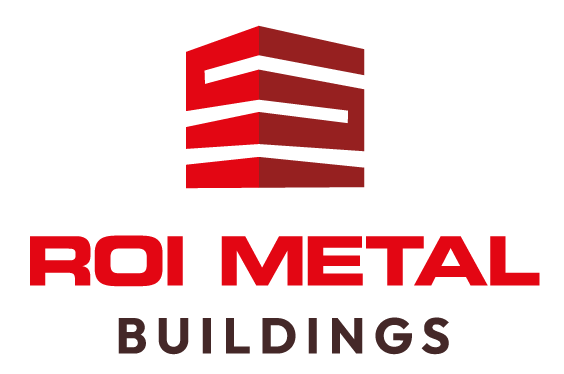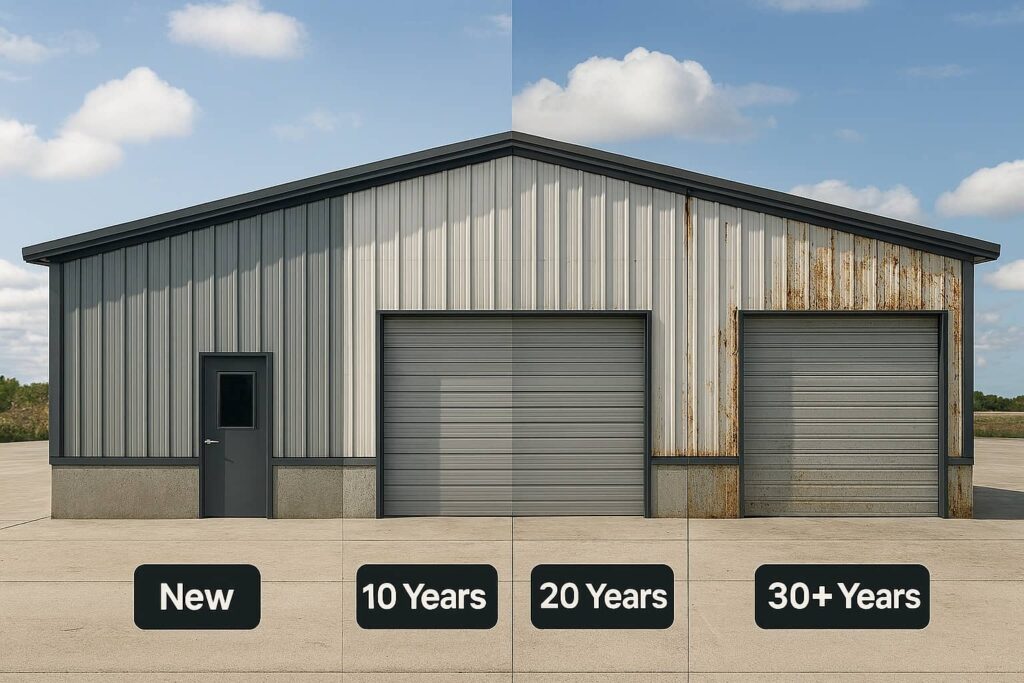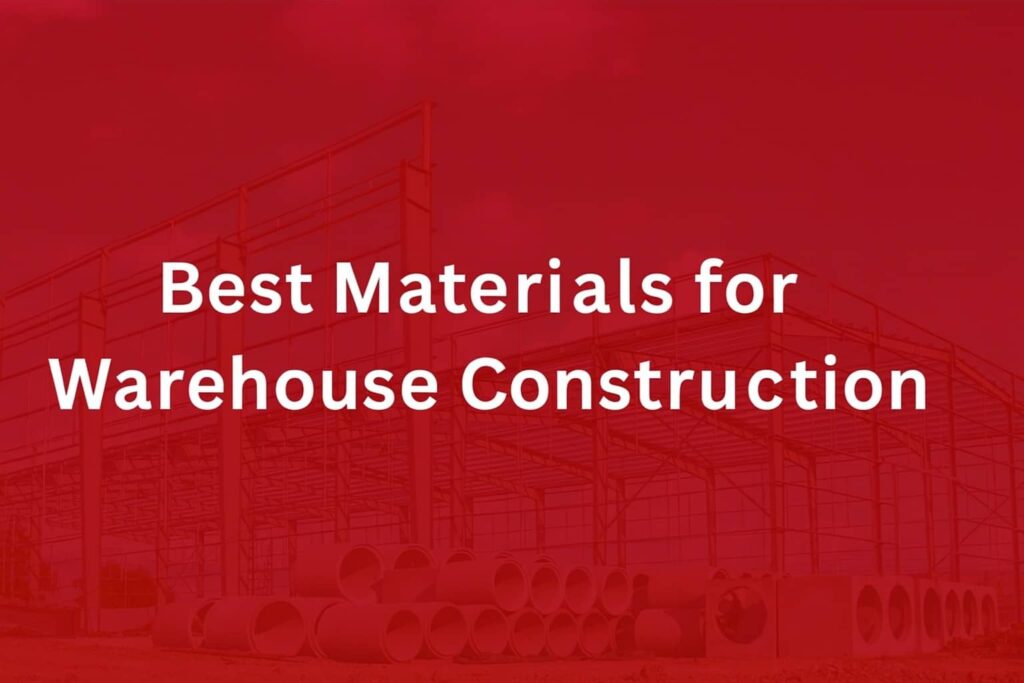The Lifecycle of a Metal Building
Whether you’re investing in a metal building for commercial use, storage, or a custom workshop, the real value isn’t just in the initial build; it’s in how that structure performs over decades. From the first concrete pour to year 30+ upgrades, metal buildings follow a predictable lifecycle shaped by climate, maintenance, and evolving needs. In Colorado’s high-altitude environment, understanding this timeline isn’t just smart, it’s essential for protecting your investment and planning.
- Metal buildings require phased care, not just upfront investment. From site prep and permitting to mid-life upgrades and long-term repairs, each decade brings specific maintenance needs that impact performance, safety, and ROI.
- Proactive planning extends lifespan and reduces costs. Routine inspections, moisture control, and timely upgrades help prevent common issues like rust, insulation breakdown, and foundation shifts, especially in climates like Colorado’s.
- Lifecycle awareness supports smarter decisions, from design to resale. Understanding how a metal building evolves over 30+ years empowers owners to budget wisely, stay compliant with codes, and adapt the space for changing needs or future buyers.
1. Introduction
Metal buildings are known for their durability, cost-efficiency, and versatility, but what does their long-term performance actually look like? This guide walks you through the full lifecycle of a metal building, from initial construction to decades of use, maintenance, and upgrades.
Whether you’re a property owner, contractor, or investor, you’ll learn:
- What to expect during the first few years of construction and setup
- How to maintain and upgrade your building through each decade
- Common issues like rust, insulation breakdown, and foundation shifts, and how to prevent them
- A breakdown of costs over time, including ROI, resale value, and the life expectancy of metal buildings
- Tips for maximizing longevity, energy efficiency, and structural integrity
By the end, you’ll have a clear roadmap for managing your metal building across 30+ years, helping you plan smarter, spend wisely, and extend the life of your investment.
2. Phase 1: Planning and Construction (Years 0–2)
The first two years of a metal building’s life are all about laying the groundwork, literally and strategically. This phase sets the tone for long-term durability, energy efficiency, and cost control. Selecting the right construction materials and building materials for your metal building project is crucial, as key factors such as intended usage and local environmental conditions will directly influence the structure’s performance and longevity.
Site Prep and Permitting
Before any steel goes up, the land needs to be ready:
- Grading and drainage: Ensures water flows away from the foundation, preventing future rust or shifting. Assess the building site for local environmental conditions that could affect drainage and foundation stability.
- Soil testing: Confirms load-bearing capacity and helps avoid costly foundation issues.
- Permitting: Local building codes, zoning, and fire safety regulations must be cleared—especially in Colorado municipalities like Castle Rock or Pueblo.
Tip: Partnering with a local contractor familiar with permitting process can save weeks of back-and-forth.
Design Choices: Framing, Insulation, Roofing
This is where function meets form: The choice of construction materials and building materials is heavily influenced by the building’s intended usage, as different applications require specific features for optimal performance and longevity.
- Framing systems: Choose between rigid frame, clear span, or modular designs based on use (e.g., warehouse vs. retail). Pre-engineered steel buildings and pre-engineered metal buildings offer flexibility and efficiency for a variety of intended usages, providing strong structural support and faster construction times.
- Insulation: Batt, spray foam, or insulated panels, each affects energy efficiency and condensation control. Proper insulation is essential for maintaining energy efficiency, protecting against moisture, and ensuring the building envelope is sealed against weather elements.
- Roofing: Galvalume vs. painted panels, pitch angle, and snow load ratings all matter in Colorado’s climate. Incorporating fire-resistant steel and high-quality wall panels enhances safety, durability, and thermal efficiency.
Construction Timeline and Inspections
Once materials arrive, the build moves fast, but oversight is key:
- Timeline: Most metal buildings go up in weeks, not months, depending on size and complexity.
- Inspections: Foundation, framing, electrical, and fire safety checks are required at key milestones. Proper installation and attention to key factors during the construction process are essential for ensuring long-term durability and performance.
- Punch list: Final walkthrough ensures everything meets spec before occupancy.
3. Phase 2: Early Years of Use (Years 3–10)
Once your metal building is operational, the first decade is all about monitoring performance and staying ahead of minor issues before they become costly repairs. During this phase, the structure settles into its environment, meaning you might notice subtle shifts, insulation settling, or wear around high-traffic areas. Regular maintenance and meeting maintenance requirements are crucial to ensure your building is properly maintained and continues to perform optimally. Routine maintenance becomes essential: inspecting roof seams for leaks, checking fasteners and panel alignment, and keeping gutters clear to prevent moisture buildup. Be sure to check for loose fasteners and inspect doors, including garage doors, to ensure smooth operation and prevent operational issues. These tasks are simple but critical for long-term durability. Building owners are responsible for regular cleaning and proper care, which helps extend the building’s lifespan and maintain its appearance and structural integrity. It’s also a smart time to consider upgrades based on how the building is used, like adding HVAC systems, improving insulation for energy savings, or reinforcing entry points for security. Owners who stay proactive during this phase often extend the building’s lifespan and reduce future costs, especially in climates like Colorado’s, where seasonal extremes can accelerate wear.
Key Tasks and Upgrades (Years 3–10)
Category | Action Item | Purpose / Benefit |
|---|---|---|
Structural Check | Inspect seams, fasteners, and panel alignment | Prevent leaks and maintain integrity |
Structural Check | Inspect and tighten loose fasteners | Maintain structural integrity |
Moisture Control | Clean gutters and downspouts | Avoid rust and foundation issues |
Maintenance | Inspect doors and garage doors | Ensure smooth operation and prevent rust |
Maintenance | Regular cleaning of building exterior and interior | Prevent dirt buildup and corrosion |
Insulation Review | Check for settling or gaps | Improve energy efficiency and comfort |
System Upgrades | Add HVAC or ventilation | Enhance usability and climate control |
Security Enhancements | Reinforce doors, windows, and access points | Protect assets and reduce liability |
Documentation | Keep records of inspections and repairs | Support resale value and warranty claims |
4. Phase 3: Mid-Life Maintenance (Years 11–20)
By the second decade, your metal building has likely weathered its fair share of seasons, storms, and operational shifts. This phase is all about preserving structural integrity and adapting the space to meet evolving needs. Routine mid-life maintenance includes applying roof coatings to prevent leaks and UV damage, touching up exterior paint to protect against corrosion, and inspecting insulation for gaps or moisture intrusion. Many owners also explore expansion or repurposing options, whether it’s adding square footage, converting storage into workspace, or upgrading the layout for new tenants. Energy efficiency becomes a priority too, with upgrades like LED lighting, smart thermostats, and improved insulation helping reduce operating costs. Staying proactive during this phase not only extends the building’s lifespan but also boosts resale value and long-term ROI.
Mid-Life Maintenance & Upgrade Checklist
Task / Upgrade | Purpose / Benefit | Notes for Colorado Climate |
|---|---|---|
Roof Coating Application | Prevent leaks, extend roof life | UV protection is key in high-altitude zones |
Paint Touch-Ups | Protect steel from rust and corrosion | Choose coatings rated for freeze-thaw cycles |
Insulation Inspection | Improve energy efficiency, prevent condensation | Watch for moisture buildup in winter months |
Building Expansion | Add usable space for new operations | Check zoning and fire code updates |
Repurposing Interior | Adapt layout for new tenants or uses | Ideal for mixed-use or municipal buildings |
Energy Upgrades | Lower utility costs, improve comfort | Incentives may be available for LED/HVAC retrofits |
5. Phase 4: Long-Term Durability (Years 21–30+)
By the third decade, a metal building’s longevity depends on how well it’s been maintained and how prepared you are for major updates. This phase focuses on structural integrity and foundation health, especially in regions like Wyoming, where freeze-thaw cycles and soil movement can take a toll. Owners should inspect for signs of fatigue in framing connections, foundation cracks, or corrosion in load-bearing elements. Major repairs or replacements may be necessary, such as re-roofing, replacing insulation, or upgrading outdated systems. It’s also a critical time to review compliance with updated building codes, fire safety standards, and ADA requirements, especially if the building is being sold, leased, or repurposed. Proactive owners who invest in repairs and documentation during this phase often see stronger resale value and fewer surprises during inspections or appraisals.
Key Actions for Long-Term Durability and Structural Integrity
- Inspect structural framing and joints for signs of fatigue, rust, or stress
- Evaluate foundation health, checking for cracks, settling, or water damage
- Schedule major repairs or replacements like roofing, insulation, or siding
- Review building code compliance, including ADA and fire safety updates
- Document all maintenance and upgrades to support resale or leasing
- Consult local experts for zoning changes or permit renewals, especially in Colorado municipalities
Common Issues and How to Prevent Them
Even the most well-built metal buildings face wear and tear over time. By identifying common issues early and taking preventative steps, owners can avoid costly repairs and extend the life of their investment. Moisture and rust are top concerns, especially in freeze-thaw climates like Montana. Without proper drainage and protective coatings, water can seep into seams and fasteners, leading to corrosion. Foundation shifts are another risk, often caused by poor soil compaction or drainage problems. These can result in cracks, uneven floors, or compromised structural alignment. Insulation breakdown is also common, particularly in older buildings where moisture intrusion or settling can reduce thermal performance. Fortunately, most of these issues are preventable with routine inspections, smart upgrades, and proactive maintenance.
Proper Maintenance and Prevention Checklist
Moisture & Rust
- Apply roof and wall coatings rated for UV and moisture resistance
- Keep gutters and downspouts clear to prevent pooling
- Inspect seams, fasteners, and flashing annually
Foundation Shifts
- Ensure proper grading and drainage around the building perimeter
- Monitor for cracks or uneven settling, especially after heavy snow or rain
- Schedule periodic foundation inspections every 5–10 years
Insulation Breakdown
- Check for moisture intrusion, especially around roof and wall joints
- Replace or reinforce insulation in high-traffic or high-humidity areas
- Upgrade to closed-cell spray foam or insulated panels for better longevity
Conclusion
From initial construction to decades of use, every phase of a metal building’s lifecycle brings its own challenges and opportunities. The early years focus on setup and settling, followed by routine maintenance and smart upgrades in the first decade. Mid-life brings expansion, energy improvements, and protective updates, while the long-term phase demands structural inspections, major repairs, and compliance checks. Each stage builds on the last, and the most successful owners are the ones who plan ahead.
Proactive maintenance isn’t just about avoiding problems; it’s about maximizing ROI, improving comfort, and protecting your investment for the long haul. Whether you’re managing a service shop in Castle Rock or a municipal facility in Grand Junction, working with experienced professionals can make all the difference. From site prep to resale strategy, expert guidance ensures your building stays safe, efficient, and ready for whatever comes next.
Ready to Maximize Your Metal Buildings’ Lifespan?
Whether you’re planning a new build, upgrading an existing structure, or preparing for resale, ROI Metal Buildings is here to help you get the most out of every phase. From site prep and permitting to long-term maintenance and energy upgrades, our team brings decades of experience and local insight to every project.
- Custom solutions for Colorado’s climate and building codes
- Expert guidance on maintenance, expansion, and compliance
- Transparent pricing, fast timelines, and stress-free service
Let’s build something that lasts. Reach out today for a free consultation or lifecycle assessment, and discover how ROI Metal Buildings can help you protect your investment for decades to come.




